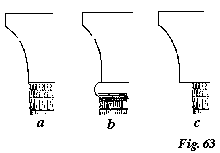DECORATION XXVII. CORNICE AND CAPITAL 373
their turn. How the Greek Doric or Greek ogee cornices were invented is not easy to determine, and, fortunately, is little to our present purpose; for the mediĉval ogee cornices have an independent development of their own, from the first type of the concave, cornice, a in Plate 15.
§ 26. That cornice occurs, in the simplest work, perfectly pure, but in finished work it was quickly felt that there was a meagreness in its 
§ 27. First group. With the roll at the base (b, Fig. 63). The chain of its succession is represented from 1 to 6, in Plate 15: 1 and 2 are the steps already gained, as in Fig. 63; and in them the profile of cornice used is a of Plate 15, or a refined condition of b of Fig. 5, p. 93 above. Now, keeping the same refined profile, substitute the condition of it, f of Fig. 5 (and there accounted for),1 above the roll here, and you have 3, Plate 15. This superadded abacus was instantly felt to be harsh in its projecting angle; but you know what to do with an angle when it is harsh. Use your simplest chamfer on it (a or b, Fig. 53, page 314 above), but on the visible side only, and you have Fig. 4, Plate 15 (the top stone being made deeper that you may have room to chamfer it). Now this Fig. 4 is the profile of Lombardic and Venetian early capitals and cornices, by tens of thousands: and it continues into the late Venetian Gothic, with this only difference, that as time advances, the vertical
1 [See above, ch. vi. § 7, p. 95.]
[Version 0.04: March 2008]